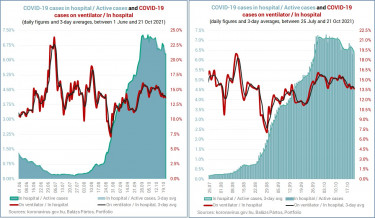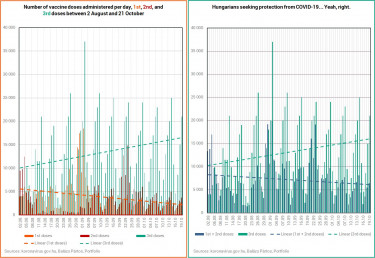Hungary preparing for restriction-free national holiday amidst worsening Covid situation

Hungarian authorities diagnosed 2,548 people with COVID-19 infection and 24 people died of coronavirus-related diseases over the past 24 hours. This compares with 2,032 new cases and 47 deaths a year ago. The key metric is the number of Covid patients in hospital, on ventilator and in the morgue, though.


It looks like we have caught up with the base period's number of new COVID-19 cases (7-day rolling average), while in terms of the 7-d rolling average of fatalities this 'wave' is not as deadly (yet).

The test positivity rate has risen further to 12.85%. It was 12.42% a year ago. The 3-day percent positive went up to almost 12%, versus 11.6% a year ago.
The 3-day / 21-day average positivity rate exceed 169% versus 133% a year ago, and the 7-day average of the 3-d/21-d ratio is almost at 150%, against 120% in 2020. The virus is spreading at an accelerating rate.



Let's compare the current situation to the one we were in a year ago. There are about 40% fewer Covid patients in hospital but only some 15% fewer on ventilator, which indicates that those that need medical help are generally in a more severe condition. This also has to do with testing practices. Underdetection is massive. Given that there were no vaccines a year ago (about 60% of the population are inoculated now, but this coverage is unlikey to go much higher) the charts below bode ill for the future.


The rising number of cases, fatalities and the more severe condition of hospitalised patients have not yet sounded the alarm in the government. It keeps saying that anti-pandemic restrictions will be implemented if the situation warrants it, but does not plan to reinstate such a blatantly simple yet effective risk-mitigating restriction as mandatory mask-wearing indoors (e.g. stores, public transport, cinema, theatre).

The charts below show the absolute number of COVID-19 patients in hospitals and on ventilators The left-hand chart depicts a longer period (15 June - 21 Oct), while the right-hand one shows changes over a shorter period (25 July - 21 Oct). 25 July was chosen as the starting point for it was when Covid hospitalisations hit their lowest. Looking back, we are already at late May levels, and the situation has been worsening sharply.

What the declining ratios on the following charts mean is that hospitals are currently being transformed into Covid centres. The 3-day average ratio of hospitalised Covid patients to the number of active cases dropped to 6.4% on Thursday from over 7% it was for two weeks (29 Sept - 12 Oct). The 3-day average On ventilator / In hospital ratio has retreated to 13.8% from over 15% in early Oct.

When the Case Fatality Rate (CFR, shown on a reversed scale below) drops the pandemic starts to gather momentum, because CFR = deaths / registered cases. There is an increasing number of new confirmed COVID-19 cases but the number of Covid fatalities is just starting to catch up. Whatever looks like a drop on the chart, is actually an increase in reality.

The pandemic is clearly taking off, as attested not only by a sharper rise in the accumulated number of new COVID-19 cases (32,000 vs. 46,700 a year ago), but also by the constantly rising number of accumulated days spent in hospital and on ventilator. Even with fewer cases more people ended up in ICUs between 28 Aug and 21 Oct this year than a year earlier.
The accumulated number of cases in the period under review, as well as the accumulated number of days spent in hospital are about 32% lower now than a year ago, whereas the accumulated number of days spent on ventilator is 12% higher.

As remarked above, the current 'wave' is not as deadly the one a year ago, at least in the period under review, but fatalities are just 'catching up' with hospitalisations, and the ventilation situation does not bode well for the future.



As regards vaccinations, those that have already received their two jabs (or one if they got Johnson & Johnson's single-dose COVID-19 vaccine) increasingly think they do need a third shot. Those that have not received any jab, continue to think they can sit this one out. We'll see. They shouldn't bet on it, though. Peace.



Cover photo: Getty Images







